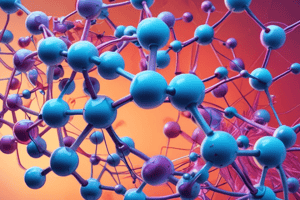Podcast
Questions and Answers
Why does carbon form covalent bonds with other carbon atoms?
Why does carbon form covalent bonds with other carbon atoms?
- Because it has a high atomic mass
- Due to its unique property called catenation (correct)
- Because it is a noble gas
- As a result of its high reactivity
What is the branch of chemistry that studies compounds formed by carbon and other elements like hydrogen, oxygen, and nitrogen?
What is the branch of chemistry that studies compounds formed by carbon and other elements like hydrogen, oxygen, and nitrogen?
- Analytical chemistry
- Physical chemistry
- Inorganic chemistry
- Organic chemistry (correct)
What is the primary focus of organic chemistry?
What is the primary focus of organic chemistry?
- Investigating the properties of non-covalent compounds
- Understanding the formation and properties of organic compounds (correct)
- Exploring the reactions of inorganic compounds
- Studying the behavior of metals
What is the IUPAC system used for in organic chemistry?
What is the IUPAC system used for in organic chemistry?
What technique is commonly used for the purification of organic compounds?
What technique is commonly used for the purification of organic compounds?
Which part of the plant is negatively phototropic and aerotropic?
Which part of the plant is negatively phototropic and aerotropic?
In which habitat would you expect to find Psammophytes?
In which habitat would you expect to find Psammophytes?
What is the primary function of the shoot system in Angiosperms?
What is the primary function of the shoot system in Angiosperms?
Which type of Angiospermic plant is adapted to growing in aquatic habitat?
Which type of Angiospermic plant is adapted to growing in aquatic habitat?
What are the primary roots of Angiosperms responsible for?
What are the primary roots of Angiosperms responsible for?
Flashcards are hidden until you start studying
Study Notes
Carbon Chemistry
- Carbon atoms form covalent bonds with each other due to their four valence electrons, allowing them to create stable structures through single, double, or triple bonds.
- The ability to form chains and rings leads to an immense variety of carbon-based compounds.
Organic Chemistry
- The branch of chemistry that explores compounds formed by carbon and elements such as hydrogen, oxygen, and nitrogen is called organic chemistry.
- Organic chemistry focuses on the structure, properties, composition, reactions, and synthesis of organic compounds.
IUPAC System
- The International Union of Pure and Applied Chemistry (IUPAC) system is utilized for naming organic compounds consistently and systematically, ensuring clarity in communication among chemists.
Purification Techniques
- A common technique for the purification of organic compounds is chromatography, allowing separation and identification of various components in a mixture.
Plant Responses
- The part of the plant that is negatively phototropic (growing away from light) and aerotropic (growing toward air) is the root system.
Psammophytes Habitat
- Psammophytes are typically found in sandy habitats, such as coastal dunes or deserts, where they exhibit specialized adaptations for survival.
Shoot System Function
- The primary function of the shoot system in angiosperms includes supporting leaves, flowers, and fruits, facilitating photosynthesis, reproduction, and nutrient transport.
Aquatic Angiosperms
- Aquatic angiospermic plants, such as water lilies and lotus, are adapted to living in water environments, exhibiting floating leaves and submerged roots.
Primary Roots in Angiosperms
- The primary roots of angiosperms are responsible for anchoring the plant, absorbing water and nutrients, and sometimes storing energy in the form of starches.
Studying That Suits You
Use AI to generate personalized quizzes and flashcards to suit your learning preferences.




